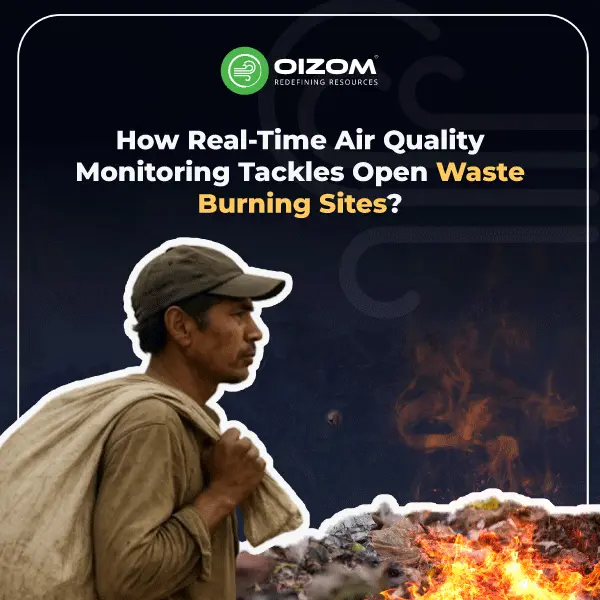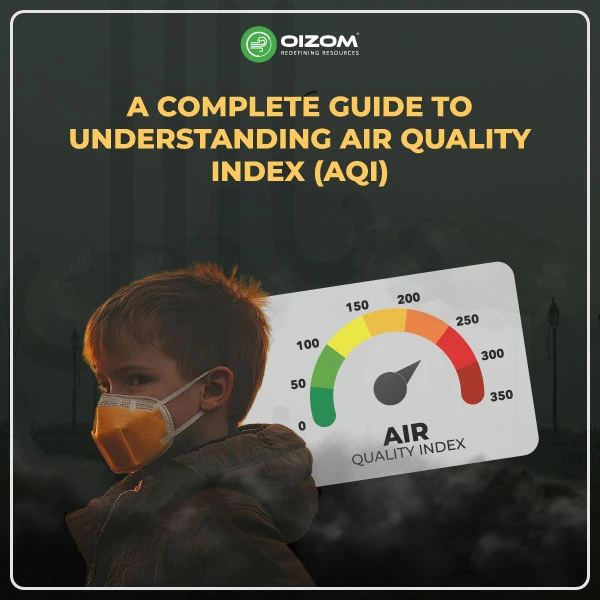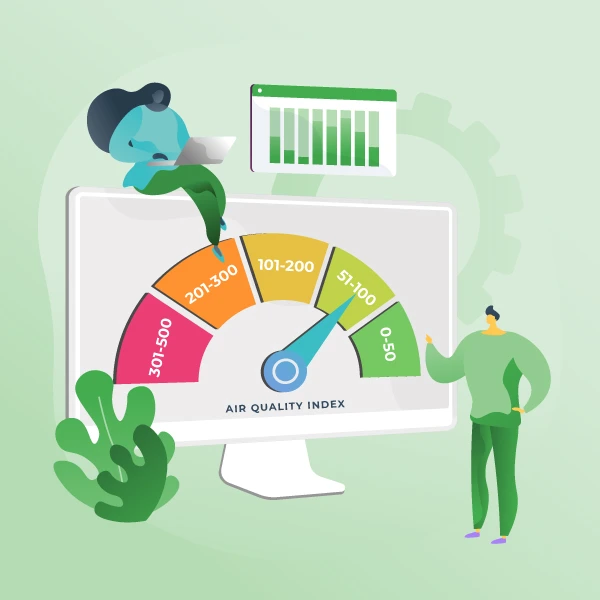Summary
Open waste burning is a significant but underestimated source of urban air pollution, emitting PM2.5, PM10, CO, and toxic gases that are harmful to public health and the environment. Poor waste management, low awareness, and inadequate enforcement exacerbate the challenge. Real-time air quality monitoring presents an obvious solution. Sensors detect pollution spikes as they occur, enabling timely responses, informing waste collection efforts, and assisting authorities in measuring the effectiveness of interventions.
Accessible information also enables citizens to get informed and report cases, making a hidden issue a shared responsibility. Mass replication of sensor networks and the application of predictive analytics allow cities to transition from reactive firefighting to proactive prevention building cleaner air and safer communities.
Introduction: Why Monitoring Open Waste Burning Sites Matters?
Open burning of waste is one of the most silent but rigorous causes of air pollution in towns and cities. Bunches of mixed waste are usually burned to clear space within a short time. Still, the smoke emitted contains a poisonous mixture of PM2.5, carbon monoxide, and toxic chemicals that remain in the atmosphere for an extended period. It is estimated that millions of tons of waste are openly burned annually, adding substantially to local air pollution and greenhouse gas emissions.
The challenge is not just the pollution itself, but also the fact that these burning events are sporadic, scattered, and difficult to track. By the time the smoke is noticed, the damage to air quality is already done. At this moment, real-time air quality monitoring is a breakthrough. By making pollution visible as it occurs, cities and communities can take prompt, targeted action to prevent prolonged exposure and protect public health.
Challenge: Why Open Waste Burning Is a Persistent Problem?
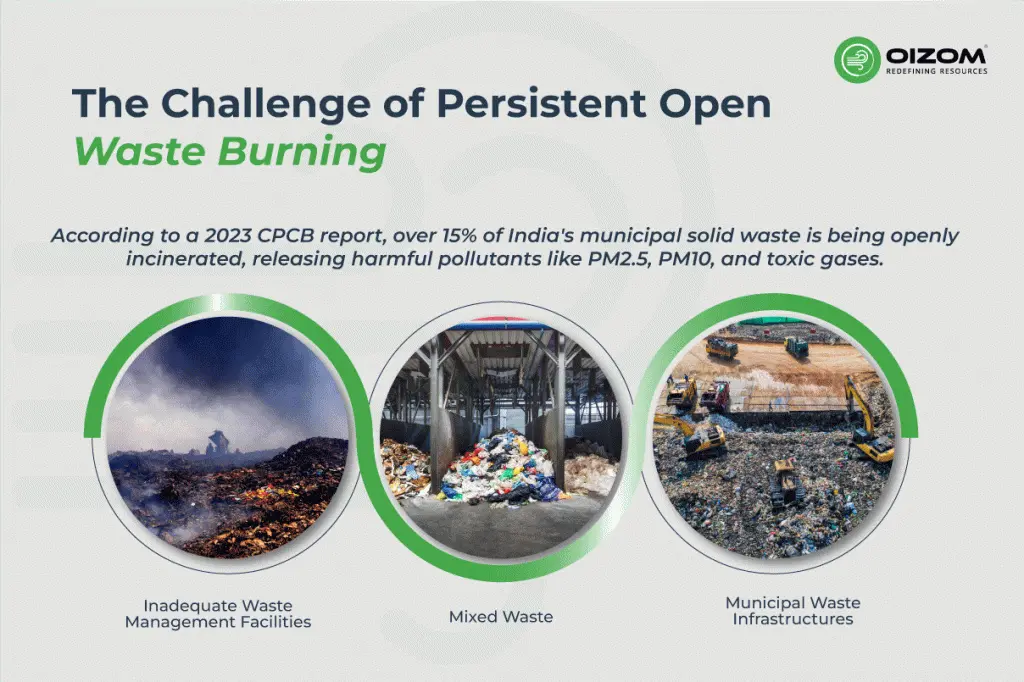
Open waste burning remains widely prevalent, despite its significant health and environmental risks. The problem primarily stems from inadequate waste management facilities, especially in peri-urban and slum areas, where waste collection services are not standard in most areas, and for them, openly burning trash is the simplest and cheapest method of disposal. According to a 2023 CPCB report, over 15% of India’s municipal solid waste is being openly incinerated, releasing harmful pollutants like PM2.5, PM10, and toxic gases.
Economic and social factors further contribute to the problem. Informal waste pickers typically rely on sifting through mixed waste, with burning being the most efficient method for disposing of non-recyclable waste. Technological and regulatory challenges, however, arise from poor enforcement and monitoring gaps that make it difficult to mitigate open burning effectively. Local government agencies often lack the personnel and updated data necessary to identify and sanction burning locations. Municipal waste infrastructures are also reactive rather than proactive, responding only after fires have occurred, rather than anticipating them.
All such social, economic, and regulatory problems collectively render the open burning of waste a recalcitrant issue. It emphasizes the importance of real-time air quality monitoring, which can provide actionable intelligence to citizens and enforcement agencies, enabling targeted interventions and improved enforcement.
Solution: How Air Quality Monitoring Helps Address This Problem?
Real-time air quality monitoring provides a practical and effective solution for addressing the challenge of open waste burning. By setting up sensors around known or potential burning sites, authorities and communities can continuously monitor levels of pollutants such as PM2.5, PM10, CO, and VOCs. This data gives a clear picture of when and where harmful emissions spike, allowing timely action before the pollution worsens.
Apart from monitoring pollutants, the systems also enable local governments to react in advance. For instance, cities such as Ahmedabad and Gurugram have used real-time monitoring to identify hotspots, determine waste collection schedules, and alert communities when air quality worsens. Such information also enables one to measure the impact of interventions over time, thereby ensuring that policies or campaigns are indeed curbing open burning.
For communities, data can be readily obtained through dashboards or apps, enabling residents to make smart decisions, such as staying indoors during pollution peaks or reporting persistent open burning to city officials. By linking monitoring with practical, real-world utilization, air quality sensors close the monitoring-action gap, converting out-of-sight pollution into in-sight, actionable information.
Implementation: Monitoring Open Waste Burning – Step-by-Step Journey
Fighting open waste burning with live air quality tracking is a systematic step-by-step process where municipal action goes hand-in-hand with public involvement:
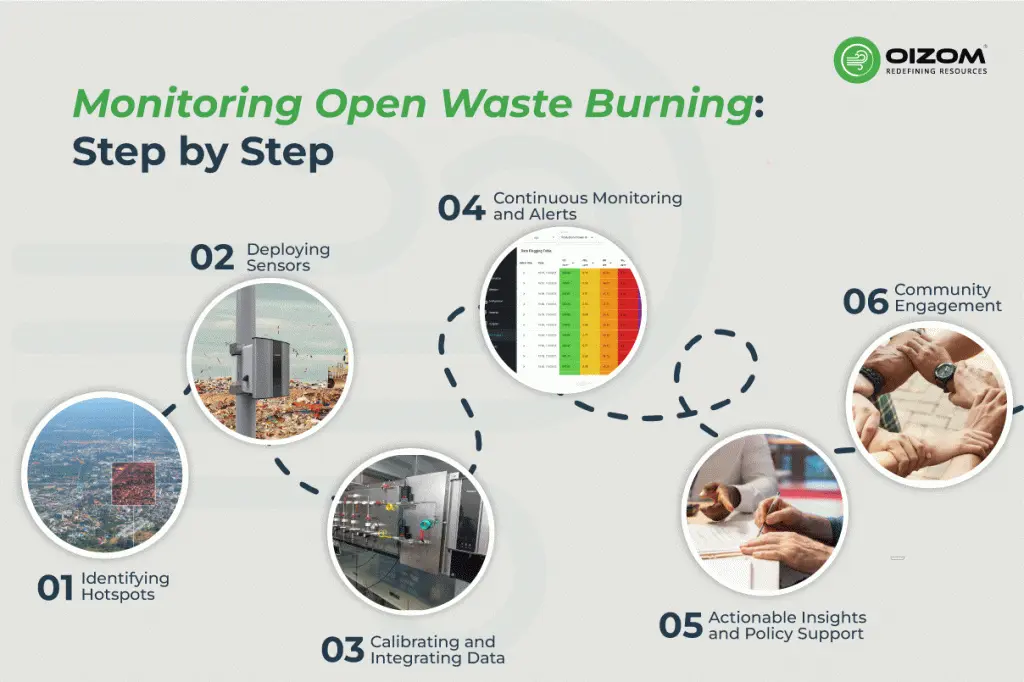
Identifying Hotspots
Mapping areas of potential open waste burning through past data, citizen complaint information, and satellite photographs ensures that high-risk locations are identified for monitoring. In cities such as Kochi, where municipal dumps have experienced repeated fire incidents, this step proves essential for targeting effective interventions.
Deploying Sensors
Air quality monitors, such as PM2.5/PM10 sensors, VOC detectors, and gas meters, are strategically placed around waste facilities and nearby local communities to provide a complete representation of pollution.
Calibrating and Integrating Data
Accurate readings are guaranteed with proper calibration. Information from multiple sensors is fed into a central platform, helping authorities and community members to monitor trends in real-time.
Continuous Monitoring and Alerts
Sensors detect pollution spikes as they occur, sending automatic alerts to city teams and citizens for prompt intervention. Real-time surveillance in Kochi has revealed that wildfires can emit substantial amounts of PM2.5, CO, NOx, and greenhouse gases, frequently impacting the surrounding populations.
Actionable Insights and Policy Support
Real-time monitoring data guides the prioritization of waste collection, resource allocation, and the design of appropriate awareness campaigns. In the long term, trends inform long-term waste management policy and enforcement strategies.
Community Engagement
Communities view dashboards or mobile apps, report constant burning, and engage in awareness programs, ensuring that data translates to effective change. By taking this organized path and utilizing real-time data, cities can turn monitoring into action, identifying surges in a timely manner, responding promptly, and addressing open waste burning in a more environmentally friendly manner.
Insights: Data Insights & Results from Real-Time Monitoring
Real-time air quality monitoring generates detailed datasets beyond mere AQI numbers. These data help provide a detailed understanding of how open waste burning impacts local air quality and determines when interventions are necessary.
1. Determining Peak Burning Hours
Prolonged monitoring typically reveals daily fluctuations, such as morning and evening peaks in PM2.5 and CO concentrations, that coincide with the period of burning. Authorities can leverage this data to plan collection or enforcement during risk times.
2. Estimating the Pollution Impact
Evidence suggests the extent to which open waste burning contributes to pollution loads. In several observed locations, PM2.5 concentration can increase 3–5 times baseline levels during a burning episode. Monitoring the data for weeks or months enables cities to quantify whether measures are actually reducing pollution peaks.
3. Connecting Weather and Dispersion
Monitoring data, along with meteorological data such as wind direction and speed, reveals the nature of smoke dispersion. This helps in predicting which neighboring residential areas are most affected and enables early alerts.
4. Monitoring Results Over Time
The most useful end-product is the before-and-after comparison. Eventually, data can indicate declining pollutant levels, fewer burning events, or better compliance with municipal regulations, providing solid evidence that action plans are effective.
5. Facilitating Long-Term Planning
These findings inform policy-making and resource planning. For instance, repeated recognition of a single hotspot could provide grounds for establishing a waste collection point or enhanced patrols in that area.
By translating raw data into observable patterns and actionable information, real-time monitoring enables air quality management to shift from a reactive process to a data-informed proactive approach, yielding tangible impacts.
Benefits: How Monitoring Helps Authorities, Citizens, and the Environment?
Live air quality monitoring offers benefits at various levels, transforming previously unseen pollution into actionable information that is useful to all parties concerned.
For governments, monitoring provides an early-warning system. It enables them to identify open waste burning incidents in real time, send response teams promptly, and focus waste collection activities on trouble spots. Over time, this information enhances compliance, reduces resources, and informs more intelligent policies based on more than just complaints from citizens.
For the public, real-time data enhances trust and knowledge. People can access live air quality data through apps or public boards, which helps them make informed decisions about when to stay indoors, use masks, or report cases of pollution. This openness empowers communities to actively participate in creating cleaner and healthier neighborhoods.
For the environment, surveillance translates to fewer uncontrolled fires and less toxic emissions. Diminished PM2.5, CO, and VOCs result in improved local air quality, reduced damage to soil and vegetation, and lower greenhouse gas emissions. The overall result is a cleaner urban ecosystem and healthier living conditions.
In brief, real-time monitoring transforms open waste burning into a visible, manageable issue from a previously silent, unmanaged one that can be resolved in collaboration, benefiting governance, public health, and the environment.
Best Practices: Lessons Learned & Recommendations for Effective Monitoring
Effective air quality monitoring of open waste burning goes beyond installing sensors; it’s about executing them properly. Here are some of the most important lessons learned and recommendations:
1. Strategic Sensor Placement
Install sensors near recognized hotspots, residential areas, and downwind points to capture the full effect. Poor installation yields inaccurate data.
2. Maintain Calibration & Ensure
Regular calibration ensures the accuracy and reliability of data. A well-serviced network prevents false alarms and instills confidence in the monitoring system.
3. Integrate Data with Action Plans
Monitoring should not be a one-way process, with data collection being the sole focus. Leverage dashboards and alerts to inform waste collection schedules, enforcement patrols, and emergency response.
4. Integrate with Community Reporting
Engage the community through live data access and a reporting tool for new burning locations. Public involvement enhances coverage and accountability.
5. Regularly Reviewing Trends
Examine long-term trends, rather than daily fluctuations, to detect systemic issues and assess the effectiveness of interventions.
6. Work Together Across Departments
Engage municipal staff, pollution control boards, and local citizens in the decision-making process to ensure a comprehensive, sustainable solution.
Adhering to these best practices ensures that efforts at monitoring pay off in actual, long-term improvements, instead of additional data going unreceived.
Future: Scaling the Solution for Wider Impact
Real-time air monitoring is not a city solution; it has the potential to drive city-wide and even national change. The future involves scaling these systems to monitor all significant open burning hotspots and provide timely air quality information to all communities.
Scaling is initiated by expanding sensor networks to cover greater urban and peri-urban regions, ensuring that no burning site escapes their notice. With the increasing volume of data, incorporating it with emerging technologies such as AI and predictive analytics can help predict burning events before their occurrence, enabling authorities to respond preemptively instead of reactively.
More broadly, making aggregated insights available to policymakers can inform waste management approaches at the national or regional level, guiding tighter regulations and more effective resource allocation. Public dashboards and apps that are user-friendly will also remain significant, making community monitoring a more accessible and user-friendly activity rather than a governmental one.
Finally, scaling this solution involves transitioning from individual interventions to a networked, data-enabled system that comprehensively addresses open waste burning, making cities cleaner and safer for all, improving public health, and lowering emissions.
Conclusion
Open burning of waste can seem like a centuries-old issue, but using the right technology, it no longer has to be an open-ended challenge. Real-time monitoring of air quality demonstrates that it’s possible to sense, react, and mitigate pollution incidents before they escalate into a widespread public health emergency. What previously went unseen can now be monitored, quantified, and addressed, holding waste management to account in ways never before.
As cities turn towards greener, healthier horizons, information will be their strongest ally. Through technology, policy, and community engagement, we can move closer to a future where open burning is no longer the default solution for waste management. Solutions such as Oizom’s Air Pollution monitoring systems bring this transition within reach, practical, and scalable.
The challenge is real, but the progress we can make is equally substantial. Every sensor, every data point, and every action taken brings us closer to cleaner air and a safer world for everyone.
FAQs
They release high levels of PM2.5, PM10, CO, VOCs, dioxins, and furans, which are harmful to both health and the environment.
By tracking sudden spikes in PM, CO, or VOC levels, monitoring systems can pinpoint the time and location of burning events, alerting authorities immediately.
It enables early warnings, allowing residents to limit their exposure, and helps authorities reduce pollution at its source, thereby preventing long-term health risks.
Modern sensor-based solutions are affordable and scalable, making it cost-effective for cities to monitor multiple sites without significant infrastructure investments.

